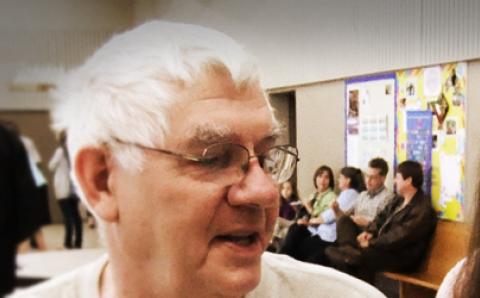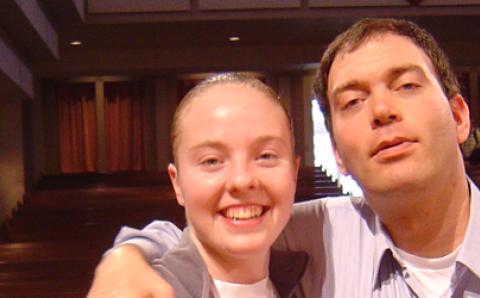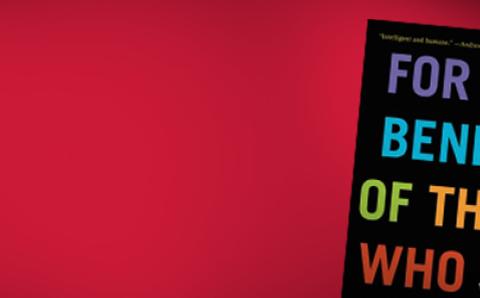In recent years, the humble comic book has been transformed into the “graphic novel,” presenting in book-length format topics usually reserved for literary writing. While Gene Luen Yang still considers himself a comic book author and artist, he has been at the forefront of pushing the graphic novel’s boundaries.
In 2006, he publishedAmerican Born Chinese, an imaginative reflection on racism and “fitting in” that has become a staple in high school English classes. Yang’s recent Boxers & Saints (First Second) traces the 1898-1900 Chinese “Boxer Rebellion.” The first volume presents the Boxers, poor rural teenagers who fought against Western domination in China. The second volume offers the perspective of the “Saints,” Chinese Christians who struggled to survive the Boxers’ violent attacks. Yang asks that we take both perspectives seriously to understand their deep-seated call for compassion. These books are best suited to readers in high school and older.
I had the opportunity to interview Yang earlier this year during Calvin College’s Festival of Faith and Writing.
Q. Why did you decide to focus on the Boxer Rebellion?
A. There are a number of reasons. First, in 2000 John Paul II canonized a group of Chinese Catholic saints. And that was the first time that the Roman Catholic Church had ever recognized Chinese citizens in this way. I grew up in a Chinese Catholic community, and my home church was really excited about it. They had all sorts of celebrations for it, and then these celebrations led me to look into the lives of these saints. I discovered that many of them were martyrs, and they were martyred during the Boxer Rebellion, specifically because they were seen as traitors to their own people.
Their canonization was also controversial. After the Vatican made the announcement, the Chinese government actually issued a letter saying that they disagreed with it, that the Catholic Church was honoring a group of people who were traitors to China. The more I read about this war, the more fascinated I became with it. I felt like it really mirrored this conflict between Eastern and Western ways of thinking that I feel like I experienced in my own life. It was like an embodiment of a struggle a lot of us feel.
Q. What is that struggle exactly?
A. I think it is a struggle between individualism and your responsibilities to a community. A lot of Chinese did convert in groups; sometimes a whole village would convert. But other times faith was seen as an individual choice. Whereas in a more Confucian understanding of the world, you have an obligation to your society, to your family, and to your village, and you can’t just go embrace some other set of metaphysical beliefs just because you think it is true. You have obligations that you need to fulfill.
I personally felt that within my own life. I don’t think that it’s just Asian Americans. A lot of immigrants’ kids feel both this Americanized pressure to pursue your dreams and pursue what your individual passions are, and also this more familial pressure or communal pressure to not let down your family. Your family has sacrificed so much for you to be an American.
Q. Why did you decide to divide the work into two volumes, Boxers and Saints?
A. It’s because I couldn’t decide who I sympathized with more. The motivations on both sides really made sense to me. On the Saints side, that’s basically the life of a Chinese Christian community, and because of my background I felt a connection with them. But even beyond that, I felt a lot of the early Chinese Christians were outcasts. They were people who had a hard time finding a place for themselves in mainstream Chinese society.
The main character in that book is actually based on a relative of mine. She converted when she was an adult. When she was born, she was born on a bad luck day according to the traditional Chinese calendar. And because she was born on a bad luck day, she had a grandfather who hated her. Later as an adult she converted to a Western faith, and she never connected these two things together. But to me it seems that the connection was fairly obvious. She was unable to find a place for herself in the culture in which she was born, so she goes and looks at other people’s stories. She looks for a reflection of herself in this foreign religion.
Q. And so the character Vibiana is given a new identity in Saints?
A. Exactly. Vibiana is born and she is not given a proper name. That happened. I don’t think it was prevalent, but it did happen from time to time with girl babies. Within Catholicism, that’s a big thing: when you are baptized [as an adult], you choose a name for yourself.
Q. It’s a beautiful moment in the book when that baptism occurs, with the full-page illustration of her. Your portrayal, however of the “Saints,” of the Christians, isn’t always positive. Father Bey is terrible—close-minded—in Boxers, but then a bit more fleshed out in Saints. Overall, the Christians are all fairly ambivalent characters. That was a definite choice on your part?
A. I wanted Father Bey to seem different between the two books. When I was researching the Boxer Rebellion I discovered there was a lot of underlying anger among the Chinese toward the Westerners. A lot of that was very understandable. The Catholics especially were fairly harsh [in Shandong]. They did things like what happened in the book. They would actually go into these villages and smash idols. Regardless of what your metaphysical beliefs are, that seems like such a disrespectful thing to do.
I wanted to portray the Boxers’ anger as something that was understandable. Because as I was researching, I felt sympathetic toward them. Their anger against the foreigners really made sense. But at the same time, having grown up in the Catholic Church, I knew that that is not all there is to the Catholic Church or to Catholic priests. Some of the people who have invested the most in my life, who have cared for me the most, have been religious Catholics. So I was hoping to add more nuance to [Father Bey’s] character in the second book.
Q. But is it to the point that you question the missionary enterprise?
A. That’s a question that plagues a lot of modern religious people. What does it mean to share your faith, and how do you do it in a way that’s respectful? In a modern world, because we are so closely connected to each other, because the world is so small through technology, there’s a tension between the solidarity of a community and the need to engage the outside world. It seems you can err in either direction. You can be a little bit too closed to the outside or too open to the outside so that you lose a sense of who you are as a people. That’s a tension. I don’t think I have a clear answer to that. And that’s why there were two books. As a Catholic, as somebody who is part of a faith tradition, I understand the importance of engaging others, of inviting others into your faith tradition, but you have to do it in a way that is authentic and that is respectful of the person you are engaging with.
Q. Boxers get a lot more pages than Saints. Why?
A. That was actually a conscious choice. For each of my stories I like to have a central motivating question or a central motivating theme. For Boxers, that motivating question was: “What does it mean to be a hero?” It’s an examination of heroism. I looked at different heroic storytelling traditions. I looked at Chinese opera and American superhero comics. I looked at Chinese war epics. [Yang cited the movie The Emperor and the Assassin.] These movies are always super-long, really colorful, and really bloody, and really sad. That’s how I wanted Boxers to read. I wanted it to be really long, and sad, and colorful, and full of blood.
In Saints, I wanted to talk about sainthood and holiness. Regardless of what world faith tradition you are part of, holiness and sainthood are almost always connected to this idea of humility. So I wanted the second book to feel much more humble. And the historical record has lent itself to that as well because the Boxers went on a long epic journal while the Chinese Christians mostly just stayed in their villages and tried to survive. So I knew the scope of the book would be different and I knew the size would be different. I wanted everything about it to be more humble: smaller, fewer colors, mostly black and white. I actually had asked my publisher to publish the second book on cheaper paper. I wanted the inside to feel like newsprint and the outside to feel like cardboard. And they were like: “We are not doing that!”
Q. The blurb on the inside of the book jacket talks about your “trademark magical realism.” Where does that come from? Is that the comic book part of you?
A. That was part of what attracted me to the Boxer Rebellion. The Boxers had this mystical belief that they could embody these ancient Chinese gods. They believed they would become bulletproof and get special powers.
There are plenty of comics I deeply admire that do not cross that line, that stay firmly in the realm of reality. [Yang cited Adrian Tomine, Optic Nerve; Harvey Pekar, American Splendor.] For my own books, I think that comics is a visual medium and introducing these fantastical elements is a way of embodying ideologies, ideas, and emotions and other invisible things. It’s a way of embodying, in a visual way.
Q. What can a graphic novel do that other media or genres can’t do?
A. Every medium has its weaknesses. The thing I really like about the graphic novel is the interplay between words and pictures. You can find a lot of richness in that in-between space. So for every piece of information I want to convey to my reader, I have to make a conscious decision as to whether to communicate that through the picture, the panel, or through the words in the captions. Each of them has a different effect. For instance, in American Born Chinese I talked a lot about stereotypes. I have a character who is a living embodiment of a stereotype. With stereotypes, you get a lot more emotional punch if you see it than if you read about it. It seems like emotion is more stark if it’s portrayed through image and it’s more subtle if you go through the words.
Q. What are the limitations of the graphic novel?
A. Sound is one. There are all these clumsy ways of representing sound in graphic novel form. I think also there is a certain subtlety that you can get out of prose novels and out of poetry that is more difficult to achieve in comics.
Q. There is a bit of snobbery about graphic novels. If you grew up with comics, that’s usually not the case, but many readers look down on them. What does that come from?
A. I’ve talked to Gary Schmidt [author and professor at Calvin College] about this and to some other friends. I wonder if it has to do with the Protestant Reformation.
Q. Wow. That’s going in the interview!
A. So here is my cockamamie theory. In Europe traditionally, words and pictures have been seen as two separate disciplines. So the people who get really good at words are not the same people who get really good at pictures. And whenever words and pictures come together, it’s seen as something that’s vulgar, like ads, or as something that’s childish. For some reason, there has always been this bias against combining them. Whereas in Asian culture, that’s not true. Like if you look at traditional Japanese printmaking or traditional Chinese brush painting, the image is always paired with the narrative or the poem. And it’s the same person doing both. The work is not considered masterful unless both of those elements are masterful.
Why is there this separation between words and pictures? If you go back further in European history, you have illuminated manuscripts, and at some point words and pictures were separated. I wonder if this was a way for Protestants and Catholics to distinguish themselves, with the Protestant rejection of image and icon. And maybe the Catholic over-embrace of it, as a way of distinguishing themselves. So I don’t know.
Q. When you are working on a story, do text and image come at the same time?
A. It depends on the scene. Some scenes come to me as a series of actions. And then there are scenes that come to me as a dialogue. Usually for a dialogue-heavy scene I’ll write out the dialogue on a piece of napkin or on some scratch paper, and then I’ll translate it into thumbnails, which are small sketches of the panels. Whereas for other scenes, for fight scenes, scenes where there’s a lot of expressive action, I’ll go directly to thumbnails without writing out dialogue.
Q. Back to Saints, I thought it very interesting that you picked Joan of Arc to be the hero that appears to Vibiana. That’s very ironic as Joan is doing what the Boxers wanted to do.
A. That’s why I picked her. The more I read of the Boxers, the more they reminded me of Joan of Arc. Joan of Arc is like a French Boxer. They are living in very similar times. Joan was seeing this incursion of the British into her homeland, just as the Boxers were seeing the incursion of the Europeans. They are both considered powerless. They were these poor teenagers, relatively uneducated. And they were both empowered by spiritual belief, different kinds of spiritual belief. But it was spiritual belief that wasn’t sanctioned by the religious authorities of their day. And both of them, empowered by their spiritual beliefs, went out and fought for their country. Both met these really grizzly ends. And both also, after their deaths, their reputations went through this rollercoaster. Joan was condemned as a heretic, and then in the 1920s was canonized. There was always this tension as to who actually was she. Was she a good person or not? In the same way, the Boxers were seen as these backwards rubes with these crazy beliefs. That’s why actually in the West we refer to this incident as the Boxer Rebellion. It wasn’t actually a rebellion because they were not rebelling against their own government. It was actually an uprising against the foreign power. But we called it the “rebellion” because immediately after they were put down, the official Chinese government disowned them, even though they had supported them during the conflict. They said, “Oh it’s a rebellion, it wasn’t an uprising. We were against it the whole time.” And that’s stuck until now, a hundred years later. When the Communist Revolution happened in China, they were resurrected were made into patriots.
Q. In relation to your talk [“Is Art Selfish?”] at Calvin College’s Festival of Faith and Writing, how do you feel that this project is an act of service?
A. Sometimes the person performing the act of service doesn’t really know how it’s going to be an act of service.
Q. You do it because of the call to do it?
A. Yeah, you do it and hope for the best. Maybe that’s true for missions too. Henri Nouwen talks about ministering from your weakness and ministering from a place of humility. I think there’s something to that. Boxers and Saints is an expression of an ambivalence that I feel I have lived with. It’s also an expression of a lived faith. I had this college professor—I did a creative writing minor at CAL [State]—who advised me. I went in to see her during office hours because I talked to her about writing about faith and about religion. I would say to her “When I try to write about faith and when I try to write about religion, it comes out so didactic, it comes out so sterile.” She said, “Don’t ever write directly about your faith. You should try to live your faith and then write about your life. Because then the faith you put out is actually messier and more authentic. It’s not doctrine you are writing about, but a lived faith. That’s what I was trying to do with these books as well, a messier lived faith. Most of us struggle with doubt, we struggle with selfishness. I hope that comes through.
Q. What about the humor you put into the story?
A. The Boxer Rebellion is such a heavy subject. It’s basically so gruesome and gory and sad and hopeless that I felt I needed to put in a bit of humor to help you get through it.
About the Author
Otto Selles teaches French at Calvin College, Grand Rapids, Mich., and attends Neland Avenue Christian Reformed Church in Grand Rapids.








